State of the NHSScotland Estate 2011
A review of asset management performance in NHSScotland, identifying the current state of the estate, highlighting areas of best practice and areas for improvement.
3.0 Performance
The State of the Estate Report will provide an annual high level assessment of the progress that NHSScotland is making on improving the performance of the management of property and assets. It is proposed to do this through:
- An annual review of the Property & Asset Management Strategies (PAMS) of NHS Boards
- Monitoring changes in 15 key performance indicators that draw from and build on the estates and facilities benchmarking work that is being undertaken nationally
- Undertaking comparative performance analysis to identify the "performance gap" between current performance and a set of realistic and achievable targets for improvement.
The results from the above will be brought together in a new Performance Framework which will link property and asset performance to service and patient needs as defined in the NHSScotland Quality Strategy's three Quality Ambitions.
The interpretation of the Quality Strategy's three Quality Ambitions to reflect the supporting function that property and assets provide in the delivery of quality healthcare services is shown in the diagram that follows.
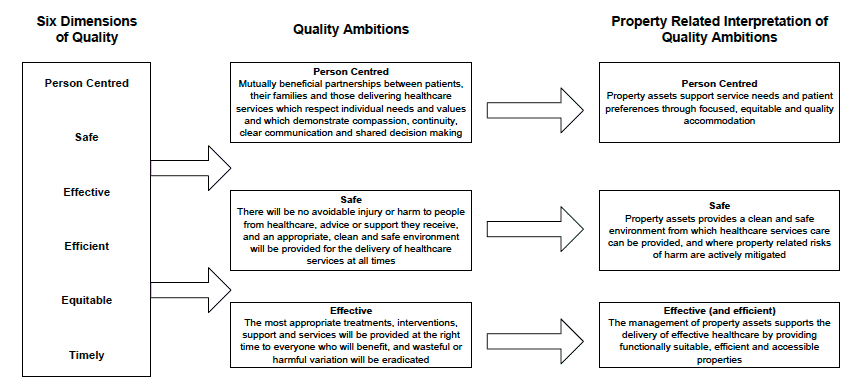
3.1 Performance framework
A new Performance Framework has been developed which will be used to appraise the overall performance of each NHS Board against the three Quality Ambitions using 15 Key Performance Indicators. The scores for each KPI will be combined to produce an overall score for each NHS Board which, once calculated, will be compared with other NHS Boards and subsequently combined to produce an "All-NHSScotland Asset Quality Ambition Score".
The State of the Estate Report will compare these scores annually and show the impact that property and asset performance improvement has on the overall performance of each NHS Board as a partner in the delivery of health and social care in their area.
The use of a Performance Framework in this way will enable current performance to be assessed, specific areas for improvement to be identified, and future improvements to be linked to plans incorporated into each NHS Board's PAMS.
The expectation is that each NHS Board will review its current performance using the framework and implement improvements linked to the targets for improvement contained within their annual PAMS update.
The annual reporting of the State of the Estate report and the All-Scotland NHS Quality Ambition Score will require a process for consistent data / information collection and collation from each NHS Board. A pro-forma based process will be developed to support this annual review and performance monitoring exercise.
The key performance indicators required to populate the Performance Framework have been selected with the aim of demonstrating that performance is improving in line with national policy and standards and across a broad range of property and asset functions.
The Performance Framework is shown below.
| Quality Ambition | Performance Measure | KPI No | Key Performance Indicator | Indicative 10 year Performance Benchmark | Current (2011) Performance | Performance Score |
|---|---|---|---|---|---|---|
| Patient Centred | Quality of physical environment | 1 | Percentage of properties categorised as either A or B for Physical Condition facet of estate appraisals | 90% | ||
| 2 | Percentage of properties categorised as either A or B for Quality facet of estate appraisals | 90% | ||||
| Patient opinion of healthcare accommodation | 3 | Positive response to Patient Questionnaire on patient rating of hospital environment' | 95% | |||
| Patient needs are accommodated in modern, well designed facilities | 4 | Percentage of properties less than 50 years old | 70% | |||
| PAMS reflective of service needs and patient preferences | 5 | PAMS Quality Checklist Overall Score (max score 100) | 95 | |||
| Safe | Statutory compliance status of property asset base | 6 | Overall percentage compliance score from SCART | 95% | ||
| Backlog maintenance expenditure requirement | 7 | Cost per square metre for backlog maintenance | £100 | |||
| Level of risk associated with outstanding backlog maintenance requirement | 8 | Significant and high risk backlog maintenance as percentage of total backlog expenditure requirement | 10% | |||
| Effective (and efficient) | Functionally suitability | 9 | Percentage of properties categorised as either A or B for Functional Suitability facet of estate appraisal | 90% | ||
| Utilisation | 10 | Percentage of properties categorised as 'Fully Utilised' for space utilisation facet of estate appraisals | 90% | |||
| 11 | Building volume (cu.m) per 1000 population (from Cost Book) | 2240 | ||||
| Property maintenance costs | 12 | Property maintenance costs £ per 100 cu.m (from Cost Book0 | £958 | |||
| Rent and rates costs | 13 | Rent and rates costs £ per 100 cu.m (from Cost Book) | £411 | |||
| Energy costs | 14 | Energy costs £ per 100 cu.m (from Cost Book) | £617 | |||
| Energy consumption | 15 | Giga Joules per 100 cu.m per year (from eMART) | 44 | |||
| Total Overall Performance Score | ||||||
3.2 Property and Asset Management Strategies (PAMS)
It is important that NHS Boards are able to describe, in a consistent way, how well the totality of their existing property and assets is performing against ongoing policy objectives both now and in the longer term. A NHS Board's Property and Asset Management Strategy (PAMS) is a key strategic document for demonstrating how the NHS Board is performing in meeting this requirement.
The Scottish Government's "Policy for Property and Asset Management in NHSScotland" requires all NHSScotland bodies to have a Property and Asset Management Strategy which is reviewed and approved annually by its Board. Health Facilities Scotland has provided comprehensive guidance and training to support NHS Boards in developing their PAMS.
One of the key aims for each NHS Board's PAMS is that as they are implemented they will fuel continuous improvement in the condition and performance of the asset base in supporting the delivery of healthcare services. The State of the Estate Report provides an opportunity to describe the success of NHS Boards in implementing their PAMS and achieving the planned benefits from it.
A PAMS checklist has been developed which is based on the requirements of the "Policy for Property and Asset Management" and the HFS guidance for developing PAMS. The checklist is aimed at identifying the strengths and weaknesses of the PAMS areas where improvement is needed, and whether or not key elements of PAMS (as identified by the PAMS guidance) have been addressed.
3.3 Review of PAMS submitted in 2011.
A deadline for the NHS Boards to produce their first PAMS was set for the end of March 2011. The PAMS that were submitted in March 2011 show that the main focus over the next few years is to complete the current major investments plans and then to refocus on backlog and improving the utilisation of existing assets. This should result in substantial improvement in overall property performance of the estate. Annex B provides a summary of the main focus and priorities of NHS Boards over the next 5 years.
The review of the quality and comprehensiveness of the PAMS documents highlighted the different stages of development of each submitted PAMS and that there is room for future improvement. The chart overleaf has been compiled using the PAMS Checklist and provides an overall score for each NHS Board's PAMS (This is a snapshot of PAMS received the deadline and does not reflect the ongoing work that has carried on and additional PAMS received since then. This will be reflected in next year's report).
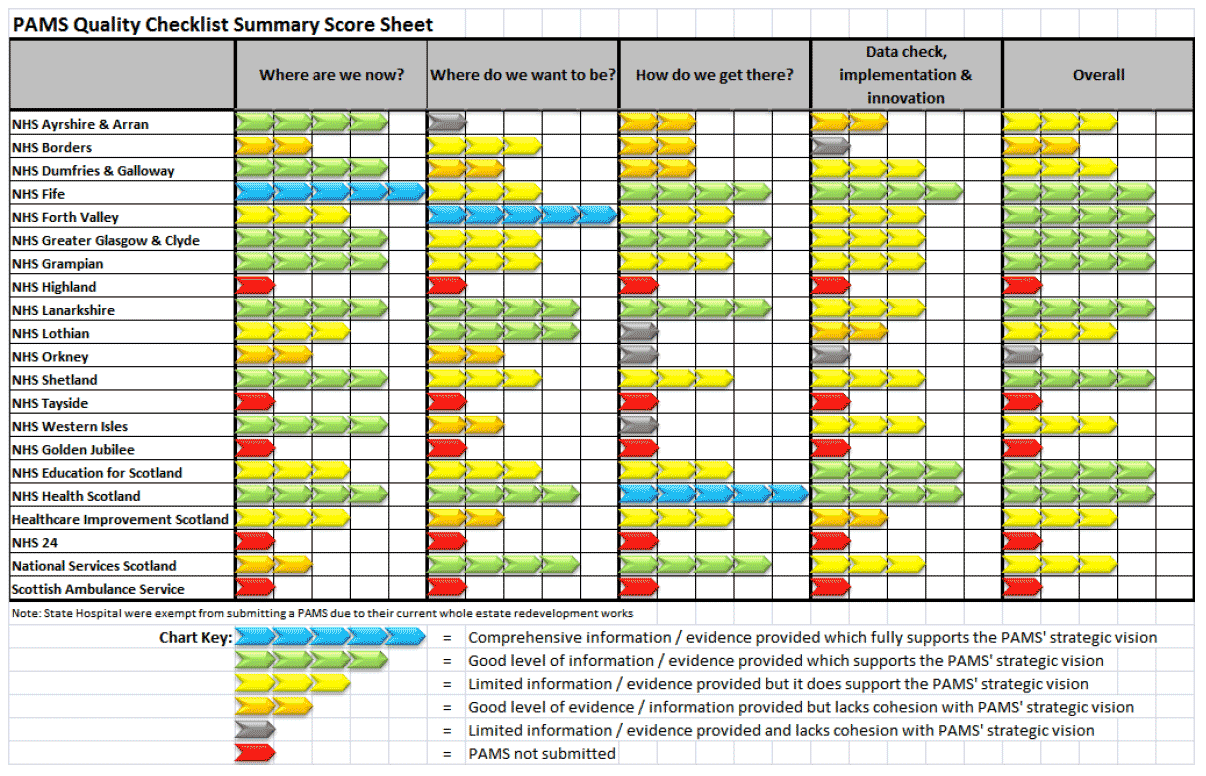
3.3.1 Setting benchmarks and targets for performance improvement
Over recent years NHSScotland has developed benchmarking information in a number of areas including Estates and Facilities Management, Energy and Environmental Management. This work is continuing through a number of benchmarking streams within the Estates and Facilities Benchmarking Group. The aim being to enable Estates and Facilities Teams within NHS Boards to identify, share and spread good practice and act on opportunities to improve performance as part of a wider need to deliver improvements in efficiency and productivity to meet local and national efficiency targets. In future years this State of the Estate Report will draw on the outcomes from the benchmarking work to support the monitoring of performance. It is intended that the benchmarking groups will be fully engaged in the development and agreement of the performance benchmarks and KPIs that will be used in future annual State of the Estate Reports.
As part of the development of this first report there has been a review of similar reports and reviews of efficiency in the NHS in England and other public sector organisations across the UK. Whilst this has shown that there are multiple approaches to identifying opportunities to improve performance, they broadly follow the same methodology. This involves establishing a performance benchmark or target, comparing each organisation against this and then determining the effect (usually efficiencies) of organisations improving their performance to the benchmark or target.
The benchmark or performance target is often arbitrarily set as the current upper quartile level of the current performance range or in some cases the top 10 percentile level of the current performance range. This approach has weaknesses for two reasons:
- If the number of organisations in the comparative or benchmark group is small (such as in NHSScotland i.e. 16 NHS Boards, 40 acute hospitals etc.) then the average and upper quartile can be very easily distorted by outliers in the data.
- It takes no account of whether or not there is a relationship between the two variables being used in the KPI, i.e. both variables may be entirely independent variables. Hence, a change in one variable may have nothing to do with a change in the other variable.
In order to overcome these problems this report has used regression analysis to establish the 10 year performance benchmarks used in the Performance Framework for the three main property costs and for asset utilisation (KPI No's 11, 12, 13 & 14).
3.3.2 Property costs
The regression analysis approach described above produces the results shown in the charts that follow and is based on information drawn from the ISD Cost Book (based on 2009/10 data) which collates the information provided by NHS Boards for 252 separate hospitals and clinics across NHSScotland.
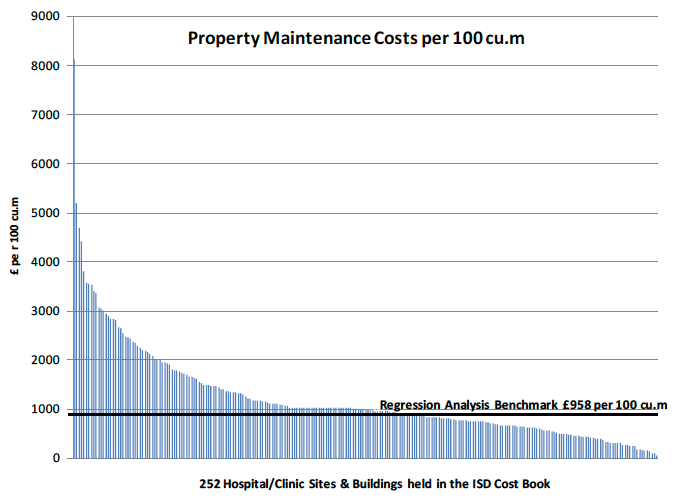
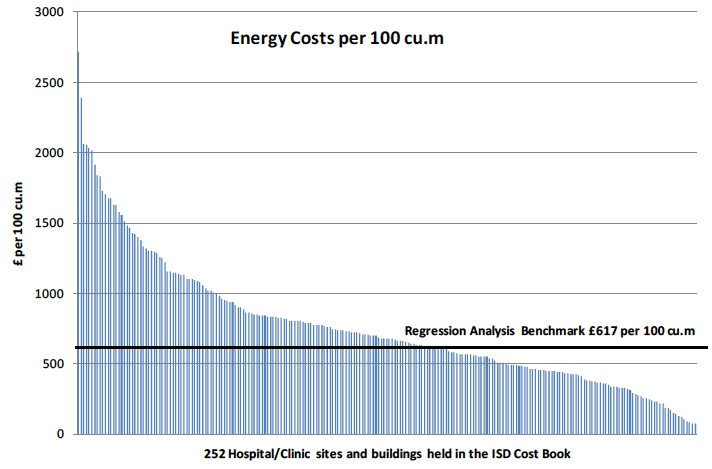
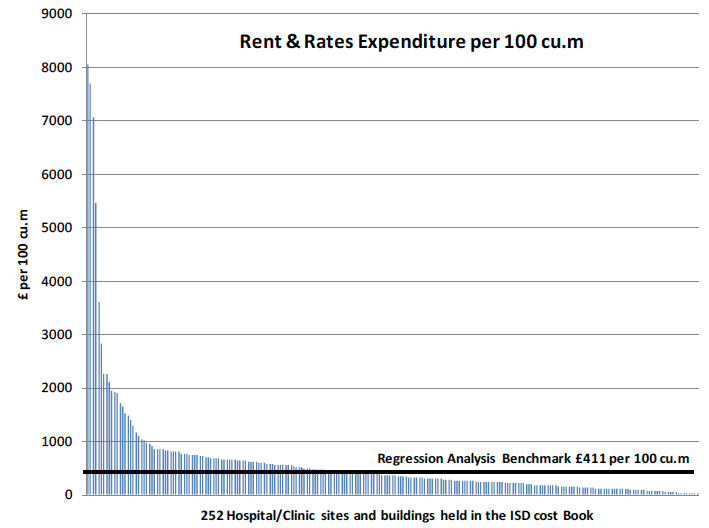
These charts clearly show that, for the three KPIs shown, there currently appears to be a very considerable variation in performance across the 252 individual hospitals/clinics sites for which information is held in the ISD Cost Book. There may be a variety of reasons behind this apparent variability in performance including poor quality and inconsistently collated information, the characteristics of the different buildings i.e. quality and condition, geographic locations etc, and different approaches to the management of these aspects of asset performance. In relation to the Rent and Rates Expenditure, the chart shows that there is a particularly wide variation in the cost per 100 cu.m and a review of this data showed that there is a need to investigate the differences in costs across the NHS Boards. This will need to be resolved if this KPI is to be meaningfully used to monitor changes in performance in future annual State of the Estate reports.
The results from this initial analysis of the property related costs, showing the apparent wide variation in performance on these three KPIs, were shared with the Steering Group which has been established for the development of the State of the Estate Report. The results have also been shared with the EAMS User Group whose members have detailed knowledge of the way in which the information submitted to the Cost Book is collated. The feedback from both groups was that the quality and consistency of the information provided by the NHS Boards for use in the Cost Book needs to be significantly improved if it is to be used for collating KPIs such as those proposed in this report.
The results from this initial exercise reinforce the importance of robust performance and management information for comparing the performance of NHS Boards and individual assets. If this State of the Estate Report is to have credibility and the targets for improving performance contained within it are to be plausible and achievable, then improving the quality and consistency of information must be a very high priority. Hence, over the last two years the Scottish Government and the NHS Boards have been implementing a number of measures to address the data quality issue including:
- The development and implementation of the Scottish Government's new Policy for Property and Asset Management in NHSScotland (CEL 35(2010))
- An extensive programme of surveys to update the information held on building condition and performance
- The development and implementation of new guidance on developing PAMS and undertaking risk based appraisals of buildings which has been supported by a series of training courses provided by Health Facilities Scotland
- The procurement and implementation of a new national Estate and Asset Management System (EAMS) which will ensure that information is held electronically in a consistent way across all the NHS Boards and can be maintained and updated regularly.
Further work is planned on improving the quality, consistency and accuracy of information used to prepare future versions of the State of the Estate Report including:
- A review of the way that information and data is collected and used in the Cost Book - a short life working group has been established which will report in January 2012
- NHS Boards will review how they collect and report on space utilisation, functional suitability and quality facets of property assets and will report by January 2012
- The Scottish Government will implement a "Review and Challenge" process on the PAMS submitted by NHS Boards and this will be incorporated into the LDP process
- Health Facilities Scotland will continue to provide a range of training courses on asset management in 2011/12.
This further work on addressing the data quality issue is expected to significantly improve the data and information which will underpin future versions of the State of the Estate Report.
3.3.3 Asset Utilisation
The analysis undertaken for this report identifies that much of the cost associated with owning and operating the estate (maintenance, energy, rates etc) is driven by its size (area/volume). Hence, asset/space utilisation is a key performance measure for efficient management of the estate.
Analysis of asset utilisation based on population
Analysis of data available from the ISD Cost Book shows that there is considerable variability in the estate volume per 1000 population across the 14 NHS Boards for which population is available. The chart that follows shows that some NHS Boards have more than 3 times the volume per 1000 population than do others.
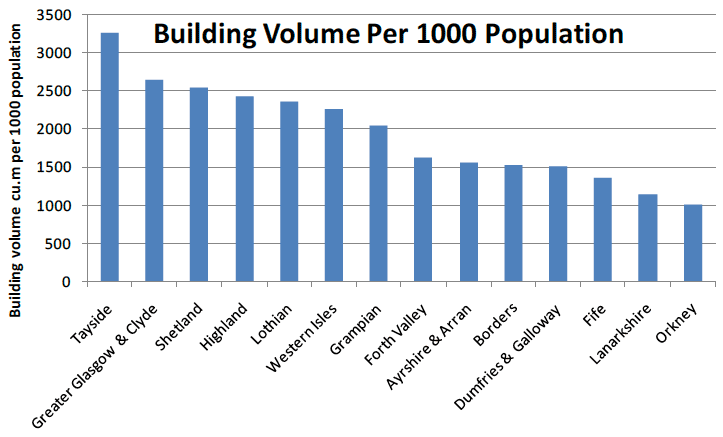
The use of the standard population in the above analysis takes no account of populations served by cross boundary activity. Therefore, two further analyses were carried taking account of:
- National Resource Allocations Committee (NRAC) populations adjusted for cross boundary flow
- NRAC populations adjusted for cross boundary spend from NHS Board's accounts.
Whilst these adjustment do have some impact on the utilisation KPI for some NHS Boards, considerable variability remains and further work is needed to better understand this apparent variation in asset utilisation across NHSScotland.
A further example of potential under utilisation of assets relates to the use of operating theatres. Analysis of the Cost Book Data for 329 theatres on 40 acute hospital sites is shown in the table and chart that follows.
| Hours used per week per theatre | |
|---|---|
| Average | 24 |
| Median | 26 |
| Max | 39 |
| Min | 0 |
| Upper Quartile | 29 |
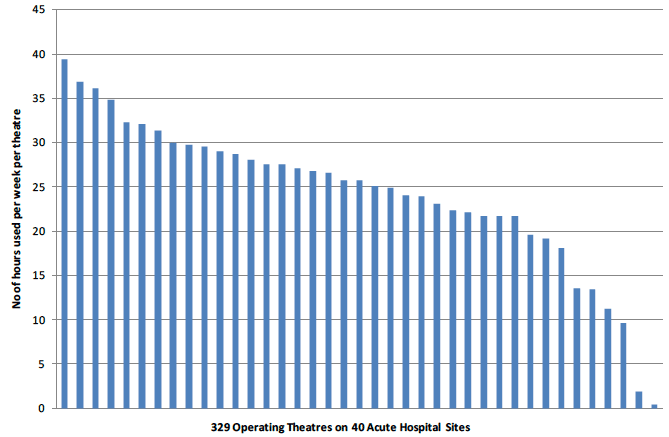
This indicates significant variation and has been considered through work that has been underway since 2008 to improve the performance of operating theatres and the quality of the cost book data on theatre use through the NHSScotland Efficiency and Productivity delivery framework.
This work identified that utilisation itself is not a good measure of operating theatre performance. It needs to be considered alongside throughput data, adjusted for case mix and complexity, planned and unplanned theatre activity, the number of cancelled theatre sessions, cancelled operations, the reason for cancellation and the efficient flow of patients along the whole operative pathway from admission to discharge. This work indicates that high utilisation rates may sometimes be an indication of poor use of theatre resources and will often be found in theatres where lists are frequently over-run due to poor planning or over-booking of theatre lists.
The Efficiency and Productivity Framework has been engaged in a comprehensive programme of benchmarking since 2007 and is able to demonstrate improvement in performance. Therefore, it is proposed that future State of the Estate Reports draw on this work to report on overall performance and to reflect the ongoing work and the wider complexities of benchmarking operating theatre performance.
3.4 The potential for improving performance and efficiency
Notwithstanding the concerns on the current accuracy and consistency of information held in the ISD Cost Book, the analysis undertaken for this first report suggest that in broad terms there is potential for improving the overall performance and efficiency of assets and estate and facilities services. In addition, the analysis has helped to develop a better understanding of the relationship between the main property related costs (maintenance, energy and rent/rates) and the size of the estate. It is now clear from this work that these property related costs are closely correlated with the size of the estate and therefore, any reduction in the area/volume of the estate will have a corresponding reduction in property costs. This is important since it is widely recognised that changes in healthcare service delivery models, driven by new technology and changing clinical practice, is reducing the need for the estate and leading to estate rationalisation. Therefore, the combination of improved performance on property costs and estate rationalisation has significant potential to reduce overall expenditure on the estate.
Furthermore, the case studies shown in Annex A describe a wide range of performance improvement initiatives covering the use of new technology, collaborative working, process redesign and the wider adoption of best practice. Similarly, the emerging work on soft facilities management services and the national procurement programme described in the annexes to this report indicate significant potential for performance improvement.
It needs to be recognised that potential efficiencies and savings relating to property and assets may not always be achievable or desirable depending on the characteristics of the asset in question. Furthermore, potential savings in property should not drive the service function; the core function and quality of service provision of the service department must always be the first consideration. Also, in some cases capital and/or revenue investment may be needed to achieve the efficiencies/savings.
Contact
Email: James H White
There is a problem
Thanks for your feedback